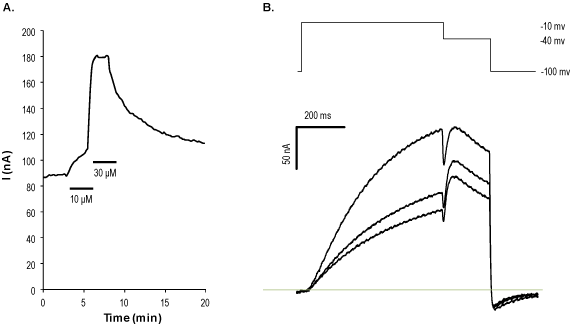Overview
 Alomone Labs NS-1643 enhances KV11.1 (hERG) currents in Xenopus oocytes.A. Time course of current amplitude at -40 mV before (see B for the voltage stimulating protocol), during application of 10 and 30 μM NS-1643 (#N-115) (indicated by bars) and upon wash, demonstrating the current amplitude enhancement. B. Superimposed example traces of KV11.1 channel current responses, before and during application of 10 and 30 μM NS-1643. Currents were elicited by 500 ms voltage step from -100 mV to -10 mV followed by a 200 ms step to -40 mV (demonstrated on top), applied every 10 sec.
Alomone Labs NS-1643 enhances KV11.1 (hERG) currents in Xenopus oocytes.A. Time course of current amplitude at -40 mV before (see B for the voltage stimulating protocol), during application of 10 and 30 μM NS-1643 (#N-115) (indicated by bars) and upon wash, demonstrating the current amplitude enhancement. B. Superimposed example traces of KV11.1 channel current responses, before and during application of 10 and 30 μM NS-1643. Currents were elicited by 500 ms voltage step from -100 mV to -10 mV followed by a 200 ms step to -40 mV (demonstrated on top), applied every 10 sec.
The KV11.1 (hERG, ERG1, erg1) channel is a member of the ether-a-go-go (EAG) subfamily of voltage-dependent K+ channels that includes the related proteins KV11.2 and KV11.3 (erg2 and erg3). The KV11.1 current is characterized by strong inward rectification with slow activation and very rapid inactivation kinetics. The channel is expressed in the brain and heart (where it underlies the IKr current) and has a central role in mediating repolarization of action potentials1,2.
Mutations in the KV11.1 channel cause inherited long QT syndrome (LQTS) or abnormalities in the repolarization of the heart that are associated with life-threatening arrhythmias and sudden death. All the identified KV11.1 mutations produce loss of function of the channel via several cellular mechanisms ranging from alterations of gating properties, channel permeability/selectivity and intracellular channel trafficking that decreases the number of channels that reach the cell membrane1,2.
Lately, drug-induced forms of LQTS have been reported for a wide range of non-cardiac drugs including antihistamines, psychoactive agents and antimicrobials. All these drugs potently block the KV11.1 channel as an unintended side effect, prompting regulatory drug agencies to issue recommendations for the testing of new drugs for their potential KV11.1 blocking effect.
In addition, KV11.1 expression was found to be upregulated in several tumor cell lines of different histogenesis suggesting that it confers the cells some advantage in cell proliferation. Indeed, in several studies it has been shown that inhibition of the KV11.1 current leads to a decrease in tumor cell proliferation3.
NS-1643 is a potent and selective KV11.1 channel modulator (enhancer)4,5. In Xenopus oocytes and in HEK-293 cells, NS-1643 increased both steady-state and tail current at all voltages. The EC50 value for hERG channel activation was 10.5 µM – 20 µM4,5. In guinea pig cardiomyocytes, application of 10 µM NS-1643 activated IKr and significantly decreased the action potential duration to 65% of the control values4. Accordingly, NS-1643 reversed acquired LQTS and Torsades de Pointes (TdP) in rabbits, caused by bradycardiac remodelling and hERG-blocking drugs6.
NS-1643 inhibited smooth muscle from bovine epididymal duct contractions with EC50 values of 8 µM7. NS-1643 also activates the ERG2 channel (KV11.2) with an apparent EC50 of 11 µM as measured in Xenopus oocytes8. NS-1643 was also found to potentiate epilepsy-associated KCNQ2 channels with an EC50 of 2.44 µM9. It has no effect on cardiac KCNQ1.

